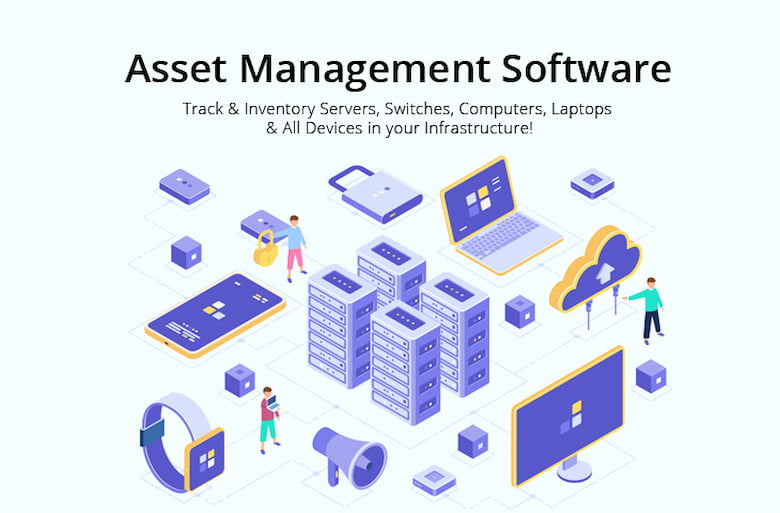Table of Contents
The importance of asset management in the business
Asset management is essential because it helps companies manage and supervise their property effectively with a systematic approach. Then, What is asset management, and why is it significant for businesses? Find out in this blog.
What is asset management? Why must manage a property?

Asset management is an overall picture of all property’s lifecycles, including when it is purchased to innovated and removed. It can apply to both visible assets (such as buildings, construction works, machinery, equipment, etc.) and invisible ones (intellectual property, financial investments, etc.). Asset management is a systematic process to develop, operate, keep track of, maintain, upgrade assets and equipment of an enterprise the most effective.
Although asset management can be manually carried out using an excel sheet, it will spend time without reaching the goal as expected. An asset management system will allow managers to keep track of the property’s overall performance best, ensuring that they are being used effectively. Thence will evaluate performance and remove unnecessary supplementary costs that could arise when assets are not well managed.
What are the benefits of asset management?

Asset management can give you the following benefits:
- Keeping track of all properties.
- Managing assets from all different locations.
- Helping to plan to prevent financial, business, and legal risks.
- Organizing a portfolio of assets properly.
- Creating more efficient activities with real-time tracking.
- Decreasing time to manage and inventory compared to traditional mode as before.
- Measuring and supervising asset lifecycle cost-effectively.
- Promoting the development of business in the future.
How to make an asset management plan
Setting the goals
Making an asset management plan must be based on the goals business want to achieve. Asking yourself what is the company trying to reach, and what are the targets in an asset management plan? When setting the goals, try to ensure that they can measure and perform.
Creating campaigns
A goal can only be achieved if you have the right strategy and action to reach it. When planning, you need to define the following issues:
- Which assets belong to the business?
- Where are they kept?
- How is the assets situation?
- How long is their life-span?
- How much is their economic value?
After answering the above issues, it will come to the determination part, planning of asset management and inventory.
Checking and keeping track of regularly
Checking and keeping track of regularly will help you efficiently supervise the costs and operation of assets. Then, accurate decisions will be offered about updating or revising the maintenance policies, upgrading or investing capital in the new property.
Applying QR Codes To Asset Management Software
Benefits of using asset management software

Asset management software will help you more conveniently control the business’s properties when they are moved within the organization or transferred between different departments. Asset management software will help enterprises efficiently manage physical asset portfolios, supporting better management of the organization’s resources.
All data on the enterprise’s assets are aggregated, stored, and managed on one system, making it easy for the management team and employees to access the documents, avoid loss, and be worn out over time.
The system will automatically send notifications when incoming assets are maintained to avoid loss and being worn out over time.
Automated inventory control: effective asset management makes stock supervision efficient and precisely and removes many troubles concerned with inventory control.
Avoiding wasteful loss of assets: enterprises can not prevent property damaged and loss during the operation and businesses. It is often difficult to have accurate figures. Using asset management software will help enterprises to stay away from loss of properties during the process.
Asset management solutions allow small firms to work better, maintain active devices and allocate resources superior. Saving time in asset management and inventory will allow businesses to improve quality and serve customers better.
Differences between Barcode and QR Code in Asset Management

What are Barcodes?
A barcode is a method of storing and transmitting information by a particular type of symbol. A barcode represents information by changing widths and distances between the bars (parallel lines).
Asset tracking with barcodes
- Using barcodes in asset tracking will bring the following benefits:
- Responsibility increase
- Error reduction
- Better data storage
- Scheduled maintenance
- Giving exactly asset location in real-time
- Decreasing workforce cost
- No time investment in employee training
What are QR Codes?
In 1994, 2D variants of barcodes were developed using more patterns than bars such as rectangles, dots, hexagons, and other geometric designs and are named as matrix codes or 2D barcodes.
QR Code (Quick Response Code) is the name of matrix code or 2D Code. The QR Code uses four standardized encoding modes: numeric, alphanumeric, binary, and kanji to store data efficiently.
The information stored inside a QR Code includes inventory tracking, sales registry, supply chain management, mobile marketing, etc.
Read more: What is a QR Code? How to create and use QR Codes most effectively?
Asset tracking with QR Codes:
- Storing up to more than 100 times data as of other barcodes
- Can scan it from any direction and at any angle up to 360°
- Easier to read and decode
- Less risky as if the QR Code is damaged, it can still scan the information
The primary difference between Barcode and QR Code
Appearance:
- Both the barcode and QR Code are different in appearance.
- Barcode: It is a linear barcode or 1D barcode represented by some lines and spaces of various parallel widths that create specific patterns.
- QR Code: It is a modern matrix barcode or 2D code represented by some rectangles, dots, hexagons, and other geometric patterns.
Information storing capacity:
- They not only look different, but they also have different levels of data storage.
- Barcode: A barcode can hold between 8-25 characters, but as the information rises, the barcode’s size also gets bigger. The information which a barcode can store is a description, item identification, pricing, information tracking, etc.
- QR Code: A QR Code can hold between 1-2,000 characters of encoded data. A QR Code can store inventory tracking, sales registry, supply chain management, mobile marketing, and logistics. The added benefit of QR Codes is the possibility of encoding images or links onto them.
The capacity of damage tolerance and data recovery:
- The level of customization and error correction is entirely different for a barcode and a QR Code.
- Barcode: Linear barcodes are less tolerant of damage and printing faults. This condition is due to the lack of redundant and error correction codes. Either joining two stripes or erasing one strip altogether will make it impossible to decode a linear or 1D barcode.
- QR Code: The maximum advantage of QR Code over the first-generation barcode is its error margin that ranges from 7-30%. The QR Code has an error correction ability and can restore data if it is dirty or damaged.
Readability:
- Barcode scanning and reading depend upon the appearance and amount of data stored in it. Both barcode and QR Code can be used effectively in a variety of automatic identification applications.
- Barcode: Linear barcodes can hold just a few dozen characters. The barcode scanners can read barcodes horizontally and do not need any direct contact with the barcode, but it should be within the range of 4 to 24 inches to scan.
- QR Code: QR Codes can hold more data than barcodes, up to 2,000 characters with mini size. The data encoding is based on the vertical and horizontal arrangement of the QR pattern, i.e., 2D. QR Code scanners can read from over 3 feet away, providing the user more flexibility in using.
Why should apply QR Codes in asset management?

QR Code asset management will benefit your business. Using QR Code asset management will speed up and automate supervision and inventory processes. Here are some of the benefits that it brings to companies.
Saving time on management and inventory
One of the benefits of using QR Codes in asset management is decreasing the time of managing and inventorying the properties. Now you can keep track of equipment status, quickly inventory with scanning QR Codes to view information, edit data in real-time without spending as much time as traditional asset management modes.
Saving the costs
Previous asset management solutions were often costly because of having to invest in separate machinery and systems for supervising. With QR Code, you need to use a smartphone to take stock of assets quickly. All data is updated in the design and can be output to excel soon.
Increasing accuracy in management and inventory process
Previous asset management and inventory methods were often done manually, so it is easy to make mistakes and not know why the figures do not match. Using QR Codes in the asset management system will help minimize the above errors.
Focusing asset management on one system
All properties are tagged with QR Codes and centrally managed on the system. Enterprises can locate, follow, update quantity and status in real-time easily.
Combining asset management software with ERP and accounting software
Using separate asset management software, you might not see the impact on your business. The integration of asset management software with ERP and accounting software will bring many benefits to businesses.
Asset management software will give you insight into a business’s asset lifecycle that can improve predictability and help you avoid unnecessary waste. Combining asset management software with ERP and other accounting software gives you more information about how asset management impacts your finances.
Tip: Create unlimited QR Codes for your company by our free tool: QR Code Generator
Nowadays, specially developed technology is making more and more new advantages to enterprises. The QR Code application is a specific example. Learning, innovating, and incorporating technologies will help enterprises improve management and business significantly. If you find this blog useful, don’t hesitate to share it with your friends!


